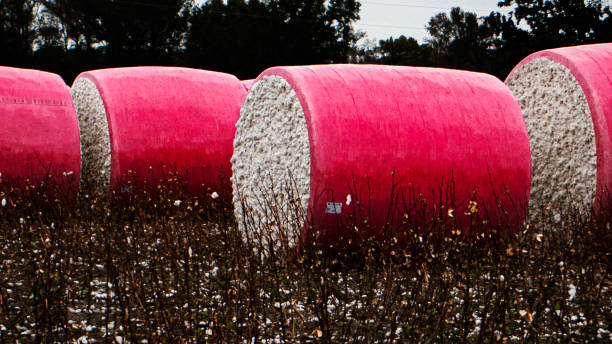1. What Is Baled Cotton?
Baled cotton refers to raw cotton that has been compressed into rectangular blocks, or bales, for easier handling, storage, and transport. Each bale typically weighs around 480 pounds (218 kilograms) and contains ginned cotton—meaning the seeds and most impurities have been removed.
These bales are the primary form in which cotton is traded globally. Before reaching textile mills, baled cotton must pass strict quality controls to ensure consistency in fiber length, color, and cleanliness, all of which impact the final fabric quality.
2. The Cotton Baling Process
The cotton baling process begins after harvesting and ginning. Once the cotton is cleaned and separated from its seeds, it’s dried and pressed into dense bales using hydraulic machinery. Each bale is then wrapped in a protective covering to preserve the cotton’s integrity during storage and shipping.
This process reduces the cotton’s bulk significantly, allowing for more efficient logistics and minimizing contamination. Baling also helps standardize cotton for commercial trade, enabling buyers and sellers to agree on quality and pricing more easily.
3. Importance of Baled Cotton in the Textile Industry
Baled cotton is the foundational raw material for the textile industry. Once it arrives at a spinning mill, the cotton is opened, blended, carded, and spun into yarn, which is then woven or knitted into fabrics for clothing, home textiles, and industrial uses.
The quality of the cotton bale directly influences yarn strength, fabric appearance, and dye absorption. As such, manufacturers prioritize sourcing bales with specific fiber lengths, strength levels, and minimal contamination for premium textile production.
4. Grading and Classification of Cotton Bales
Cotton bales are graded based on several factors: fiber length, strength, color, leaf content, and presence of foreign matter. In the U.S., for example, the USDA provides standardized grading to help ensure transparency and fairness in the cotton market.
This classification system allows producers, traders, and mills to understand the quality and value of each bale. High-grade bales fetch premium prices and are typically used in producing high-end garments, while lower-grade bales may go to industrial textiles or blended fabric products.
5. Global Cotton Production and Baled Cotton Trade
Major cotton-producing countries like the United States, India, China, Brazil, and Pakistan are also leading exporters of baled cotton. Once baled, cotton is stored in warehouses or transported via ships, trains, and trucks to domestic and international buyers.
Baled cotton is traded on global markets, including commodity exchanges, and is a key part of international trade. Market trends, weather conditions, and policy decisions in producing countries often influence prices and availability in importing regions.
6. Environmental Impact and Sustainability of Cotton Baling
While cotton is a natural and renewable fiber, its production—especially the baling process—can have environmental consequences. Water use, pesticide application, and energy consumption during ginning and baling are common concerns.
However, the industry is moving toward more sustainable practices. Eco-friendly bale wrapping materials, organic cotton certification, and improved baling technologies are helping reduce environmental impact while maintaining quality and efficiency.
7. Transportation and Storage of Cotton Bales
Cotton bales must be stored and transported carefully to prevent moisture absorption, contamination, and fiber damage. Warehouses and shipping containers need to be dry, clean, and pest-free to ensure the cotton retains its quality until it reaches the buyer.
Proper labeling and tracking of each bale ensure traceability and quality assurance throughout the supply chain. RFID tagging and barcoding are increasingly used to manage bale inventory and logistics more effectively.
8. The Role of Cotton Bales in Price Discovery
Baled cotton is a standardized commodity, which makes it easier to trade on futures and spot markets. Prices are determined based on supply and demand dynamics, influenced by crop forecasts, trade agreements, and global textile demand.
These bales are the units upon which contracts are based in many commodity exchanges, such as the Intercontinental Exchange (ICE). Accurate classification and consistent quality make bale trading an efficient way for buyers and sellers to manage price risks and inventory.
9. Advances in Cotton Baling Technology
Modern cotton baling has evolved significantly with the integration of automation and digital systems. Advanced hydraulic balers, automated wrapping systems, and computerized quality assessment tools now make the baling process faster and more consistent.
Technology also plays a key role in monitoring moisture content and fiber uniformity, ensuring each bale meets industry standards. These advancements help reduce labor costs, improve safety, and enhance the traceability of cotton throughout the supply chain.
10. Future Outlook for the Baled Cotton Market
As global demand for sustainable and ethically sourced textiles grows, the baled cotton market is expected to adapt to new consumer and regulatory expectations. Organic and fair-trade cotton bales are becoming more common in international trade.
Additionally, innovations in recycling and regenerative agriculture could reshape how cotton is grown, harvested, and baled in the future. As the industry modernizes, baled cotton will continue to be a critical link in the global textile value chain.


